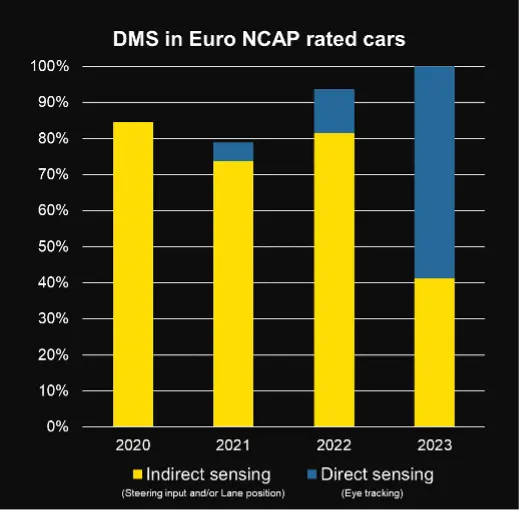
In the ever-evolving landscape of automotive safety, Euro NCAP has been at the forefront, setting stringent safety standards and encouraging technological advancements. One of the latest frontiers in vehicle safety is the integration of Interior Monitoring Systems (IMS), which promise to revolutionize how we perceive and ensure safety within vehicles. This blog explores the critical aspects of IMS, their benefits, and the new Euro NCAP rating approach that aims to accelerate their adoption.
Understanding Interior Monitoring Systems
Interior Monitoring Systems utilize a variety of sensors to detect, classify, and analyse the state of vehicle occupants. These systems are not just limited to driver monitoring; they extend to all occupants, ensuring comprehensive safety coverage. The key functions of IMS include:
- Driver Monitoring: Detecting distraction and impairment – key risk factors in many road accidents.
- Occupant Monitoring: Ensuring correct seatbelt usage, detecting the presence of a child left behind presence, and optimizing airbag and restraint deployment based on occupant classification.
The market for these systems, especially Direct Driver Monitoring Systems, is growing rapidly. With Euro NCAP incentivizing their integration since the first introduction in 2023, manufacturers are increasingly adopting these technologies to enhance vehicle safety.

The Euro NCAP Approach to IMS
Starting in 2026, Euro NCAP will implement a new rating scheme that covers four stages of a crash: Safe Driving, Crash Avoidance, Crash Protection, and Post-crash Safety. IMS will be evaluated primarily in the Safe Driving stage, under the “Occupant Monitoring” and “Driver Engagement” protocols.
Safe Driving Stage: This stage focuses on technology that supports safer driving, including:
- Occupant Monitoring: Assessing seatbelt usage, occupant classification, and child presence detection (CPD).
- Driver Engagement: Monitoring driver alertness and engagement, with technologies that can intervene if the driver is distracted, impaired or unresponsive.
Key Safety Functions of IMS
The comprehensive monitoring provided by IMS covers several critical safety functions:
- Seatbelt Use Monitoring: Ensuring all occupants use seatbelts correctly. Since 2001, Euro NCAP has assessed seatbelt reminder (SBR) systems, and is since 2019 mandated by UNECE R16. Rear seat occupancy detection is also rewarded, ensuring that all occupants in the vehicle are belted.
- Occupant Classification: Optimizing airbag deployment based on the size and position of the occupant, for instance when the passenger’s feet are on the dashboard. Also important is the determining the presence of a Child Restraint System (CRS) with the consequent deactivation of the airbag. The deactivation can be manual, semi-automatic, or fully automatic, with the latter providing the highest level of safety and scoring.
- Child Presence Detection (CPD): Systems to prevent the tragic incidents of children being left unattended in vehicles. By 2026, Euro NCAP will require CPD systems to use direct sensing technologies.
- Post-Crash Presence: Providing vital information to emergency services about the number of occupants and their status, potentially saving lives in critical situations.
- Driver Monitoring: Detecting transient and non-transient driver behaviours which may pose a risk for safe driving – including distraction and impairment – eventually ensuring safety by warning the driver or intervening with a link to Advanced Driver Assistance Systems (ADAS) operation.
The Impact of IMS on Safety Ratings
Euro NCAP’s new rating system allocates points to various safety aspects. The Safe Driving Stage, which includes Driver and Occupant monitoring, will initially require a total of 60 out of 100 points in 2026 for a vehicle to achieve a 5-star rating. The rating system will have a transition across the 3 years, gradually increasing to 80 points by 2028. euro-ncap-rating-review-2023.pdf (euroncap.com)
The Road Ahead
The integration of Interior Monitoring Systems marks a significant advancement in automotive safety. By focusing on both driver and occupant safety, these systems address some of the most critical factors contributing to road accidents. Euro NCAP’s proactive approach in incentivizing and evaluating these technologies is set to keep accelerating their adoption. Euro NCAP’s 2026 assessment will primarily reward systems offering robust and context-dependent detection of driver states that ensure acceptance and real-world safety outcomes.
Conclusion
Interior Monitoring Systems represent a pivotal development in vehicle safety technology. With Euro NCAP’s stringent new rating protocols set to take effect in 2026, the automotive industry is on the brink of a significant transformation. These systems not only enhance safety but also pave the way for more intelligent and responsive vehicles. As we move towards this safer future, it is crucial for manufacturers, policymakers, and consumers to support and adopt these life-saving technologies.
Connect on this topic in the exhibition
AutoSens and InCabin include a technology exhibition with an array of technical demonstrations, vehicle demonstrations, buck demos from world leading companies. Engineers who come to AutoSens and InCabin have the opportunity to not only discuss the latest trends but actually get their hands on the tech and see it in action.
Ready to join the adventure and dive into the technical world of ADAS and AV technology? Our Barcelona exhibition will feature all these companies and more at the cutting edge of this technology.



